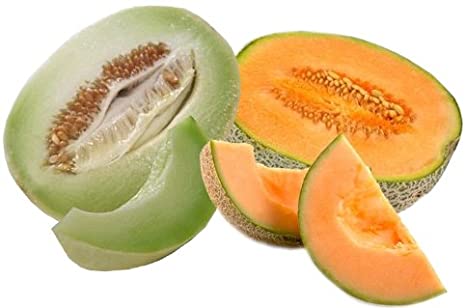What's the Difference Between Cantaloupe and Honeydew Melon
Cantaloupe or Honeydew – how do you decide which to purchase at the farmers market or roadside stand?
Let’s start out by learning what they each are.
Honeydew melon and cantaloupe are two members of the same species, Cucumis melo. Although they are closely related, they’re two different fruits. They are both sweet, but their appearance is different. Honeydew has a smooth, light-colored rind and green flesh, while cantaloupe has a darker, netted rind and orange flesh.
They both share similar nutritional benefits except for vitamin C and beta-carotene. Cantaloupe contains twice the amount of vitamin C as does honeydew, 61% DV versus 30% DV in honeydew. In vitamin A, Cantaloupe wins again with 68% DV compared to 1% DV in honeydew. Both are based on a 3.5 ounce serving. If it is beta carotene you are wanting, cantaloupe is the melon you want.
Honeydew and cantaloupe have more similarities than differences.
They both have 90% water content and the same number of calories per bite, as well
as similar amounts of fiber and phenol phytonutrients and similar trace amounts of
B vitamins and minerals.
These melons are loved for their juiciness and sweet flavor. They add color and firm
texture to fruit salads and make a beautiful addition to a fruit platter. Since they
have similar taste and texture, they can be used interchangeably in most recipes.
There is a taste difference in the two. Honeydew melon is slightly sweeter with a firm, green flesh, while cantaloupe has softer, orange flesh.
To choose cantaloupe and honeydew, follow these rules.
Select fragrant, symmetrical cantaloupes, heavy for their size with no visible bruises and a yellow or cream undertone. The stem end should give to gentle pressure. Honeydew should be well shaped and nearly spherical. They should have a waxy, not fuzzy surface and feel heavy for their size.
Food safety with cantaloupe and honeydew
When it is time to eat your melon, care should be taken to reduce the risk of unwanted bacteria entering the melon, especially on the cantaloupe who has a rough netting, a great place for bacteria to grow. Wash your hands and all utensils before and after cutting. Rinse the whole melon under cool running water; gently scrub the rind with a natural bristle brush, and then pat dry before slicing. This rinsing process will help remove unwanted bacterial contamination.
They both should be stored uncut at room temperature for up to 1 week. Once cut they must be refrigerated in an airtight container. Cantaloupe will last for up to 5 days, while honeydew melons will last up to 2 weeks in the refrigerator once cut.
Melons do not continue to ripen, or get sweeter once picked, yet they will soften somewhat.
To ripen, place the fruit in a brown paper bag rolled closed at the top to help the melon ripen faster for eating. Let sit for two to three days until they feel springy under slight pressure. Don’t forget to check for over ripeness. A softening of the entire rind and soft watery flesh shows this. Small bruises will not hurt the flesh, but large bruised areas should be avoided, since they generally cause soft, water-soaked areas underneath the rind.
You can purchase melons from the store or farmer's markets that are tasty during the summer. Just let your nose do the work for you and you should have a sweet treat for a hot summer day.
Honey Dew and Cantaloupe add color to this Summer Melon Fruit Salad. It is the perfect addition to whatever meal you are grilling outside. Substitute or add any fresh fruit you have.
Summer Melon Fruit Salad Recipe
- 1 cup Lemon Nonfat Yogurt
- 1 tablespoon Honey
- 1 teaspoon Lemon juice,
- 2 cups Watermelon, raw
- 2 cups Melons, honeydew and cantaloupe
- 2 cups Strawberries, raw
In a salad bowl, whisk together the lemon yogurt, honey, and lemon juice until smooth. Set in refrigerator to meld flavors. Arrange fruit in serving container. Before serving, gently fold in the fruit. Toss to coat and serve.
Nutrition Facts Per Serving:
99 calories; 3 g protein; 22 g carbohydrates; 38 mg sodium.
By Carla Due
cdue@uada.edu
